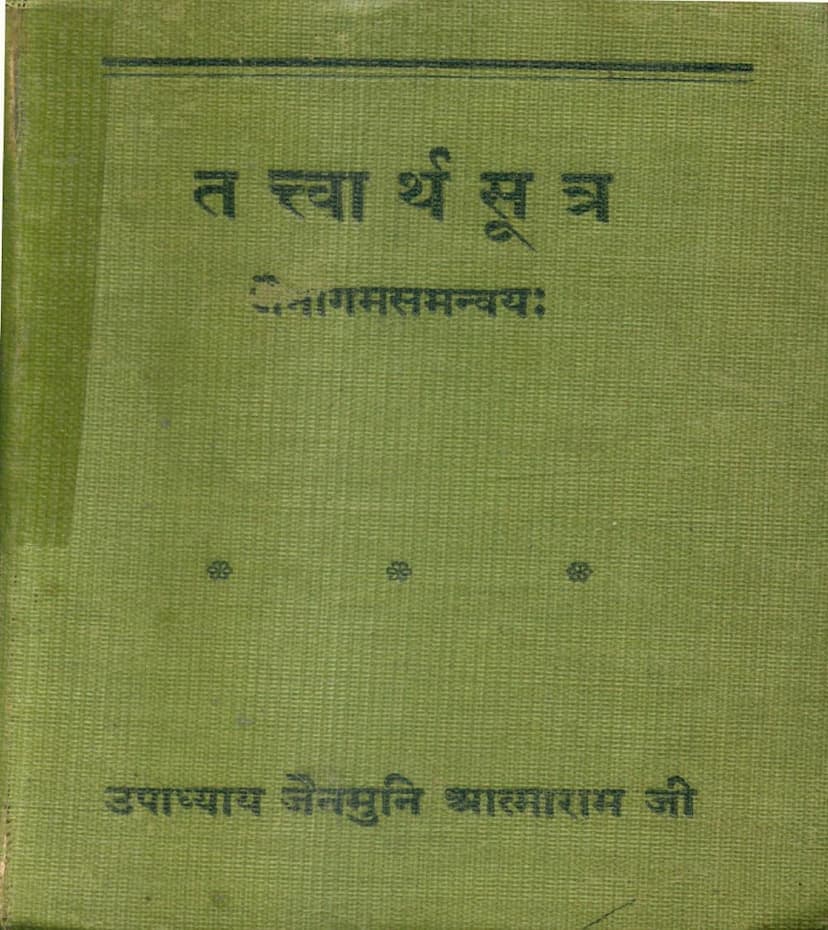Tattvartha Sutra Jainagam Samanvay
Added to library: September 2, 2025

Summary
This document is a comprehensive summary of the book "Tattvartha Sutra Jainagama Samanvay" (तत्त्वार्थसूत्र जैनागम समन्वय) authored by Upadhyaya Muni Shri Atmaramji Maharaj. The book aims to harmonize the Tattvartha Sutra, a foundational Jain text, with the Jain Agamas (sacred scriptures).
Here's a breakdown of the key aspects of the book as presented in the provided text:
Core Concept:
- The central idea of the book is to demonstrate how the Tattvartha Sutra, composed in Sanskrit, is deeply rooted in and can be correlated with the Agamas, which are primarily in Ardha-Magadhi Prakrit. Upadhyaya Atmaramji Maharaj's work aims to show that the Tattvartha Sutra, while a concise and systematic presentation of Jain philosophy, draws its content from the vast corpus of the Agamas.
Author and His Background:
- Upadhyaya Muni Shri Atmaramji Maharaj: He is presented as a highly respected scholar and monk of the Sthanakavasi sect. His expertise extends to traditional Jain philosophy and literature, as well as comparative studies.
- His Previous Works: The foreword mentions his previous valuable contributions, including translations of various Agamas (Anuyogadvara, Avasyaka, Dasasrutaskandha, Dasavaikalika, Uttaradhyayana) into Hindi and the compilation of "Jaina-tattva-Kalika-siksa."
- Scholarly Approach: He is lauded for his thorough scholarship, including comparative analysis of Jain texts with Buddhist literature and, in this present work, correlating the Tattvartha Sutra with the Agamas.
The Tattvartha Sutra:
- Significance: It is described as the earliest extant Jain work in Sanskrit, composed in the sutra style.
- Authority: It is considered authoritative by both the Digambara and Svetambara traditions.
- Author: Umasvati (or Umasvami according to Digambaras), who lived approximately 2,000 years ago.
- Commentaries: Its importance is highlighted by the existence of around forty commentaries on it.
The 'Samānvaya' (Harmonization/Correlation) Aspect:
- Methodology: The author has meticulously found passages within the Jain Agamas that correspond to each individual sutra of the Tattvartha Sutra.
- Comparison Basis: The Digambara recension of the Tattvartha Sutra was chosen for comparison, potentially to highlight the fundamental agreement between the two major Jain sects.
- Similarity: The passages quoted from the Agamas often exhibit a striking similarity in both wording and meaning to the sutras of the Tattvartha.
- Purpose: This correlation serves to:
- Substantiate the Tattvartha Sutra's origins from the Agamas.
- Prove that the Tattvartha Sutra is a compilation and not a mere creation of Umasvati.
- Assist students in understanding the deeper connections between the Tattvartha Sutra and the Agamas.
- Promote harmony and mutual understanding between different Jain sects.
- Serve as a "key" to the Agamas.
Key Themes and Chapters (as indicated by the chapter titles provided in the page content):
- Chapter 1 (Prathamo'dhyāyah): Focuses on the definition of the path to liberation (Moksha Marga) as Right Faith, Right Knowledge, and Right Conduct. It details different types of knowledge (Mati, Shrut, Avadhi, Manahparyaya, Kevala) and their classifications, drawing parallels from Agamic sources.
- Chapter 2 (Dwitiyo'dhyāyah): Discusses the soul's states (Bhavas) such as Aupashamika, Kshayika, Mishr, Audayika, and Parinamika. It elaborates on different types of life forms, bodies, senses, and the causes of bondage.
- Chapter 3 (Tritiyo'dhyāyah): Covers the cosmology, describing the structure of the universe, the different hellish realms (Narakas), the Jambu continent, the Meru mountain, and the various regions and rivers.
- Chapter 4 (Chaturtho'dhyāyah): Deals with celestial beings (Devas) of various classes (Bhavanavasi, Vyanantara, Jyotishka, Vaimanika), their abodes, lifespans, and subdivisions.
- Chapter 5 (Panchamo'dhyāyah): Explains the non-sentient substances (Ajiva) such as Dharma, Adharma, Akasha, and Pudgala, their properties, and the concept of substances (Dravyas).
- Chapter 6 (Shashtho'dhyāyah): Focuses on the influx of karmic particles (Asrava) into the soul and the causes of bondage, elaborating on the three types of actions (kaya, vacha, manah yoga), passions (kashayas), and their classifications.
- Chapter 7 (Saptamo'dhyāyah): Details the vows (Vratas) and their subdivisions (Anu-vratas, Guna-vratas, Shiksha-vratas) and the restraints (Samvara) through various practices like Gupti, Samitis, and the eighteen types of Parishad (hardships endured by ascetics).
- Chapter 8 (Ashtamo'dhyāyah): Discusses the eight types of karmas (Jnana-avaraniya, Darshana-avaraniya, Vedaniya, Mohaniya, Ayushya, Nama, Gotra, Antaraya) and their numerous subdivisions and durations.
- Chapter 9 (Navamo'dhyāyah): Expands on the concept of Samvara (cessation of influx) and Nirjara (shedding of past karma) through practices like meditation (Dhyana) and austerity (Tapas). It details the different types of Dhyana and the hardships (Parishaha) that ascetics undertake.
- Chapter 10 (Dashamo'dhyāyah): Explains Moksha (liberation) as the complete cessation of all karmas, the highest state of existence achieved through the destruction of ignorance and the attainment of Kevala Jnana (omniscience).
Significance and Appreciation:
- The book is highly valued by scholars and Jain institutions for its scholarly rigor and its contribution to understanding Jain philosophy and the interconnectedness of its scriptures.
- Several prominent scholars and institutions (Professors from Oriental College Lahore, Banaras Hindu University, Gujarat Vidyapeeth, Hamburg University, etc.) have provided endorsements, recognizing the book's immense value for research and study.
- The publication is also noted for its clear printing, handy format, and attractive binding.
In essence, "Tattvartha Sutra Jainagama Samanvay" by Upadhyaya Muni Shri Atmaramji Maharaj is a crucial work that bridges the Tattvartha Sutra and the ancient Jain Agamas, providing a scholarly and harmonious interpretation of Jain teachings.